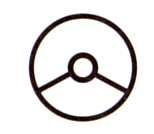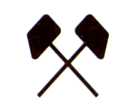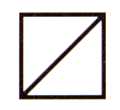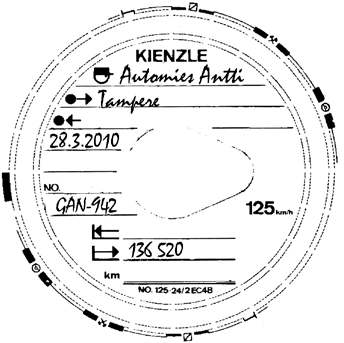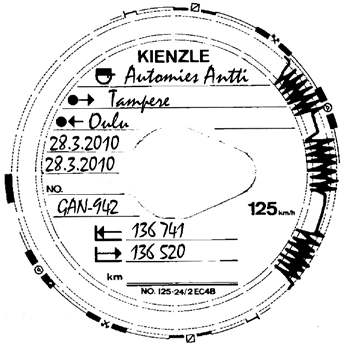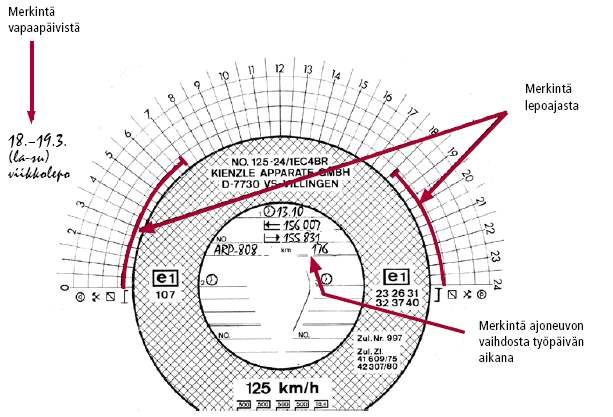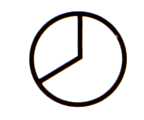

Employment relationship
Instructions on tachograph functions and how to use them
Using the mode switch on recording equipment
Drivers must use the tachograph mode switch.
|
= driving time
|
|
= other work
|
|
= period of availability
|
|
= breaks and rest periods
|
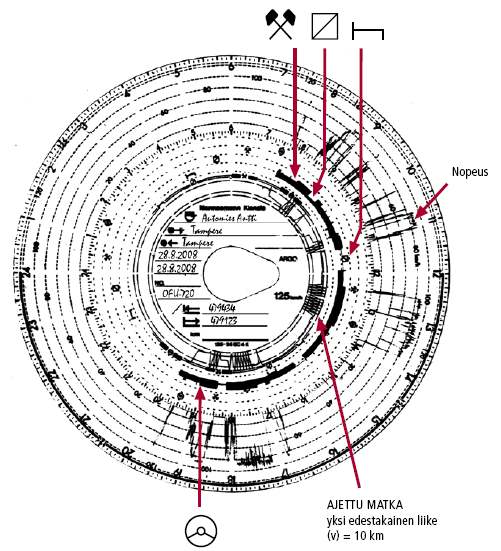
Markings to be made on record sheets
The following information must be entered in the centre of the record sheet when a driver begins their shift:
|
|
The following information must be added to the centre of the record sheet at the end of each shift:
|
|
The following information must be entered at the back of the record sheet whenever a driver switches vehicles:
|
Checklist for using a tachograph
Analogue tachograph
- Record sheets cannot be shared between drivers. Each driver is personally responsible for using their tachograph and making the necessary markings on their record sheets.
- If a tachograph malfunctions, the necessary entries must be made manually on the time-scale on the reverse of the record sheet.
- A broken tachograph must be sent in for repairs within one week. Tachographs must be inspected at least once every two years.
- Other periods during which a driver is unable to use their tachograph must also be recorded manually on the time-scale on the reverse of the record sheet.
- It is the driver’s responsibility to make sure that there are enough empty record sheets in the vehicle to last the entire journey before they set off.
- Transport companies have a duty to keep their drivers’ record sheets for a period of at least one year and to keep them in good order.
Digital tachograph
- Each transport company needs a company card that allows them to lock the tachographs that they use.
- It is the transport company’s responsibility to ensure that no driver of theirs who does not have a valid driver card is given a vehicle fitted with a digital tachograph (except when a tachograph does not need to be used).
- Transport companies must copy all driving time and rest period data pertaining to their drivers from their vehicles’ digital tachographs
- at least once every two months in the case of vehicles based in Finland
- whenever a vehicle based in another country enters Finland, and
- whenever a vehicle is sold.
Using the OUT mode
When using the OUT mode, drivers must keep in mind that, pursuant to Article 6(5) of the European Driving Time and Rest Periods Regulation (Regulation (EU) No 561/2006), drivers must record as “other work” any time spent as described in Article 4(e) as well as any time spent driving a vehicle used for commercial operations not falling within the scope of the Regulation, and also record any “periods of availability”, as defined in Article 15(3)(c) of Regulation (EEC) No 3821/85, since their last daily or weekly rest period. This information must be entered manually either on a record sheet or a printout or by using the manual input facilities on the recording equipment.
- The OUT mode is designed for recording operations that do not fall within the scope of the Driving Time and Rest Periods Regulation. See: Exceptions.
- Any movements of a vehicle in OUT mode are deemed to constitute “other work” as opposed to “driving time”.
- A driver card must be used even when a tachograph is in OUT mode if the driver’s shift includes any driving that falls within the scope of the Driving Time and Rest Periods Regulation. It is also recommended to use a driver card for shifts worked entirely in OUT mode in order to make recording working hours easier and to avoid having to input data manually.
- If a driver card is not used on journeys made entirely in OUT mode, the details of both the journey in question and all other work must be entered using the manual input facilities on the recording equipment.
Special circumstances
Deviations from driving times
The nature of and reasons for any unforeseen deviations from normal driving times (due to, for example, extreme weather conditions, accidents or lack of parking) or if a vehicle needs to be moved during a break or a rest period must be recorded manually on the record sheet (on the reverse) or on a strip printed out from the recording equipment.
Evidence of other work performed
Drivers must produce reliable evidence of any work that they perform outside of the transport sector for all days from which record sheets or driver card data are not available.
Annual leaves and sickness absences
Annual leaves and sickness absences must also be entered to record sheets or recorded manually to a driver card.
Records of fines and warnings
Drivers must keep records of any fines or other warnings given to them for breaches of driving time and rest period rules in Finland, other EU Member States or other countries that observe the AETR (such as Russia) for at least the same period of time as they keep their record sheets and have the records with them in their vehicle. The aforementioned records or other warnings must be presented to a competent control authority upon request.
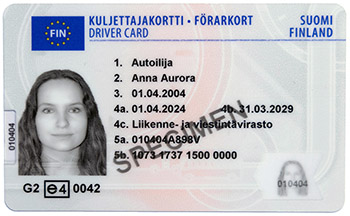
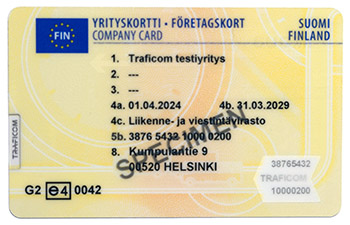
This website is part of the European Commission's Your Europe portal. Did you find what you were looking for?


